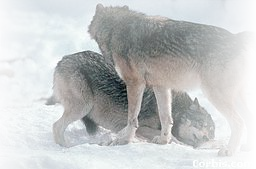Facial gestures and body postures
Wolves use a variety of facial gestures and body postures to show where they stand in the pack's hierarchy. The position of a wolf's tail can be used to tell whether or not it is a dominant wolf or a subservient wolf. The alpha wolves of a pack generally hold their tails up very high, and the subservient wolves keep their tails hanging down. Very low ranking wolves will hold their tails between their legs or curved alongside their legs, and subservient wolves often tuck their tails between their legs when approaching an alpha wolf to show that they acknowledge the alpha wolf's place in the pack's hierarchy.
The position of a wolf's tail can also be used to tell what kind of a mood it's in. A confident wolf holds its tail up high, and a frightened wolf will hold its tail between its legs.
Wolf Facial Expressions:
The position of a wolf's ears can also be used to tell where it stands in the pack's hierarchy or how it is feeling. Alpha wolves always keep their ears erect, while lower ranking wolves often keep them flattened, particularly when they approach an alpha wolf. A wolf who is feeling cautious or apologetic will hold its ears back against its head, and a happy, confident or playful wolf will hold its ears high and erect. A wolf that wants to threaten another will hold its ears forward. Also, dominant wolves (regardless of fun) urinate with the raised leg position and subservient wolves squat down to urinate. The condition of a wolf's fur can also be used to determine its status. Subservient wolves generally keep their fur flat, while alpha wolves keep their fur looking more fluffed-out. All of the guard hairs on a wolf's body will stand on end if it is trying to threaten another wolf, and it will also raise its upper lip to bear its teeth.
Defensive aggressive behavior is displayed by animals that would rather flee but are prepared to fight if necessary. The animal is fearful but feels it may be able to hold its own if the threat persists. Elements of threat and submission are combined in their postures, or may visibly alternate as the animal "waffles" between one option and the other. An animal may simultaneously grimace in fear and snarl, or alternately growl and whine. The hackles are erect, the back humped, but at the same time the animal crouches submissively, keeps its tail and ears down, and avoids staring directly at its opponent.
Submissive behavior probably originated as soliciting behavior between offspring and parent; the movements often parallel. Weaned pups food-beg from adults by approaching in a submissive crouch -- back curled, head held low to the ground, muzzle turned up -- and licking the underside of the adult's muzzle; later in life, a crouch and muzzle-lick from one adult animal to another is an active submission gesture. The submissive animal may whine or paw at the dominant one and will weave in and out in front of the animal's face, licking at its muzzle. The tail is held between the legs or to one side and wagging weakly; the eyes are narrowed and the head turned away, the lips retracted in a submissive grin, or "fear-grimace". In passive submission, the dominant animal initiates the submission behavior in the subdominant, often growling or staring to make the subdominant animal lie down, flatten its ears, and roll over on its back, in a purely indefensible position. The dominant animal will often stand over the submitting one and growl at it or bite and mouth it to "remind" it of its position in the social order.

Yearling submitting: A yearling is always subordinate to an elder or more mature wolf, and shows its place by lowering itself and laying back its ears in submission. The older wolf shows its dominance by erecting its ears, raising its tail and shackles, to appear bigger.

 Free Forum Hosting
Free Forum Hosting